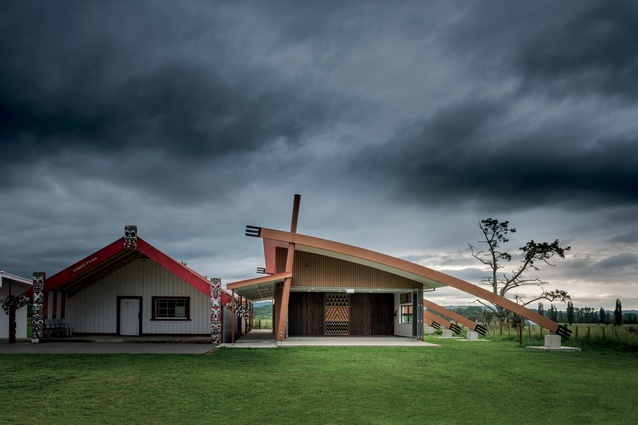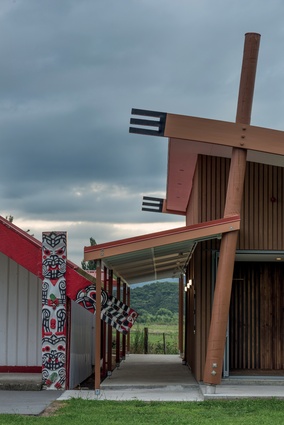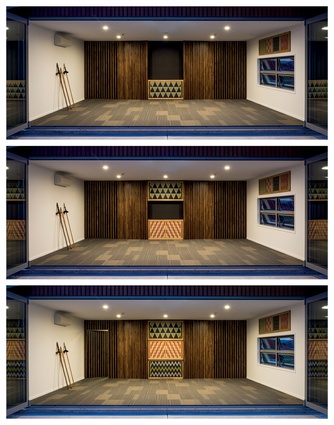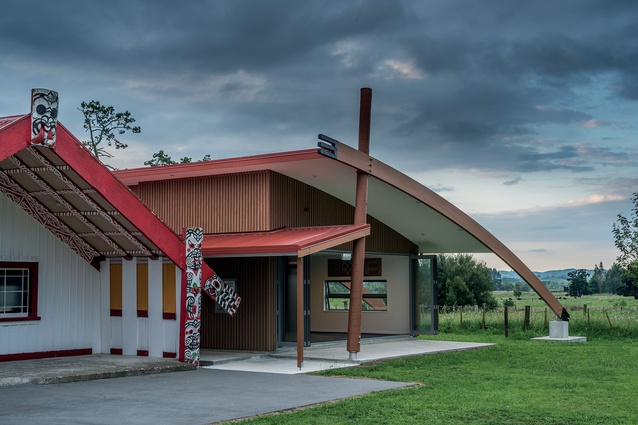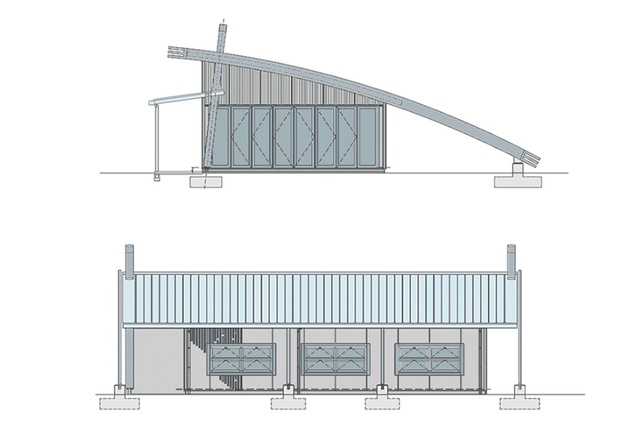Old and new: Tanatana Marae’s wharemate
At Waimana on the northern edge of Te Uruwera, a modest wharemate – designed by Apa Architects – absorbs the creation myth of Rangi and Papa in its form.
Tanatana Marae sits on the banks of the Waimana River at the northern edge of Te Uruwera forest – about 30km south of Whakatane. This is a small marae within a remote area, home of Ngāti Rere, one of 12 Ngai Tūhoe whanau in the surrounding area.
Marae committee chair Martin Rakuraku describes his whanau (family) as having its origins in Te Uruwera and its roots in the Tauranga River and the sacred mountain Maungapohatu. “Eighty per cent of our people have left the valley now but some are returning and we needed a place for bereaved family to be comfortable in grieving for their departed,” explains Rakuraku.
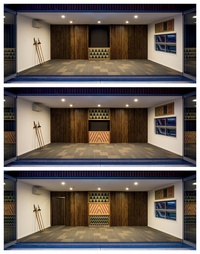
“But we are fortunate that we haven’t had to use it yet,” he says wryly. “However, just prior to October 2015, we had quite a few eulogies in our family so that was one of the reasons that led to this [project]. I guess Tūhoe is quite unique in that we build a place where a body can lie and, when I say ‘build’, in recent times we’ve relied on tents and temporary makeshift places where the body will lie throughout the three-day duration of a tangi [mourning ceremony].”
With their own funds and lottery grants in place, the tribe decided it was time to invest $375,000 in a more protective wharemate that would sit alongside their wharenui Te Poho ō Tūhoe (1919), which overlooks the sacred atea [the open area in front of the wharenui]. “We also needed the wharemate to house our taonga [prized objects],” says Rakuraku.
Rotorua-based Apa Architects were commissioned to design the building, with completion of the project timed to be ready well ahead of Tanatana Marae’s 100-year celebration in July 2019, which around 500 people will attend.
The design brief for the wharenui was for sleeping space for immediate family members alongside the body, and additional space for extended family members in an adjacent space, including storage, and an outdoor space and disabled toilets out the back.
A feature wall divides the space in two main spaces and is decorated in native timber battens, which conceal the sliding mechanisms of several panels that control and alter the room’s function and access. Tukutuku panels made by locals slide vertically to reveal an LCD screen for multi-media retelling of the deceased’s life story.

“With a tight budget, the whanau could have ended up with a simple prefabricated box and it would have met their physical needs, but they knew it would not meet their spiritual needs,” says architect Aladina Harunani from Apa Architects. “It is difficult on a restricted budget to do something unique in architecture… we could have done a hip roof with gable ends but we wanted to test the brief and to see if the finance would allow for a more modern form.”
It was crucial for the people inside the wharemate to be connected back to the atea and Harunani responded by keeping the frontage over the atea as open as possible. “We decided to include bi-fold doors so you can open up the whole front, but, when funds are limited and you want to create a big opening, then you need a big steel beam which we couldn’t have due to the cost, so we have a timber roof trusse instead. And once you pick up that trusse, then you get a flat ceiling. We modeled it in 3-D to look at the views outside, as if you are sitting in a chair or on a mattress,” explains Harunani.
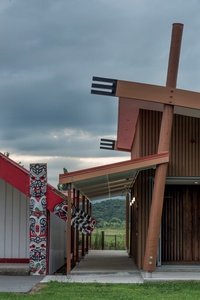
There is a stream running behind the building so Harunani brought the window down low to create a landscape view because people are often seated on mattresses and participating with the outside space. “These views were very important to the client because the surroundings are so natural and serene and the atea is where everything is happening,” he adds.
Conceptually, the inclined pole of the form is a ‘tree’ that represents the forests of Te Uruwera, the curved fascia is the building rising out of the earth and the three fingers at each end are the arms of the ancestors. It’s Rangi and Papa – one arm holds the earth and the other reaches for the sky. Together, the pole and fascia form the Christian cross, a unique cross on a lean and with a curve, representing the special beliefs of Tūhoe.
Sustainability is a crucial aspect of all of Tūhoe’s projects. Here, the timber for the battens, plywood and poles were sourced from their own forests. The marae also recycles its rainwater and has a self-reliant waste disposal. Light sensors and LEDs are used to conserve electricity. Extra insulation was added and the building was positioned so the slab could act as a heat sink.
Tūhoe people are also known as Ngā Tamariki ō te Kohu or ‘the children of the mist’. In Te Uruwera now, there are a number of new buildings being designed and built. “We are moving out of the mist,” jokes Rakuraku. “We’re very happy that we’ve come this far. It’s the first building project of any form that we’ve [his whanau] undertaken for almost 30 years – and creating something that’s a bit out of the square for some.”

